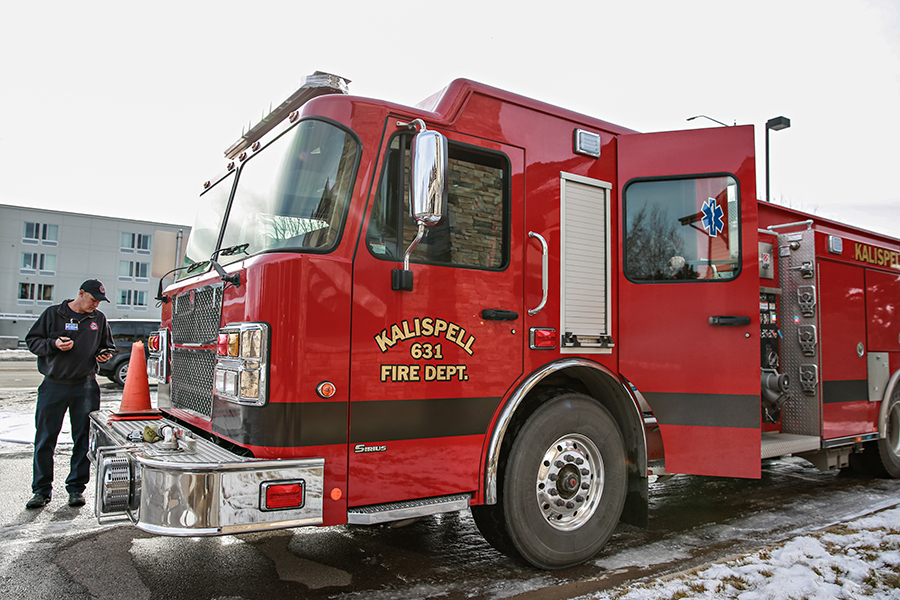Kalispell Council Reviews Emergency Responder Levy Options
Voters will decide if they want an increased level of service from the city’s fire and police departments this spring in a special election
By Maggie Dresser
The Kalispell City Council at a Monday work session reviewed the funding options for an emergency responder levy that will be on the ballot in the spring of 2024.
City staff and councilors looked at three different options that would increase staffing and equipment within the Kalispell Police Department (KPD) and the Kalispell Fire Department (KFD) to address the municipality’s growth, which has outpaced public safety resources.
Option two, which is recommended by city staff, would create 23 additional staffing positions and an additional $400,000 would also be allocated for equipment. For a property with a market value of $450,000, it would cost a resident $236 annually or $19.71 per month. The levy totals to $2.9 million.
Option three would create 38 additional staffing positions, $400,000 for equipment and a third fire station, which would be located on a city lot on Farm to Market Road on the west side of the city. For a property market value of $450,000, it would cost a resident $369 annually or $30.82 per month. The levy totals to $4.6 million.
Option one, which is not recommended and is provided for reference, would create 20 additional positions and add $200,000 for equipment. For a property value of $450,000, it would cost a resident $193 per year or $16.15 per month. The levy totals to $2.4 million.
City staff has proposed the levy in response to reports conducted by the Center for Public Safety Management that concluded that Kalispell’s population growth has outpaced its resources.
In the report, a consultant recommended adding one more firefighter per shift and constructing a third fire station along with more patrol staff, detectives and crime analysts.
The levy is also prompted by the city’s inability to add more funding to the departments from the general fund. The fire and police departments currently absorb about 74% of the budget.
City Manager Doug Russell said there’s an $800,000 gap between expenditures and revenue, which grows wider every year.
[The funding] isn’t there and this is the challenge we face every year in fixing this gap … the natural response we hear is just fit it in,” Russell said. “Well, it’s not really a place to fit in or cut something else to make it work.”
“That’s why we’re looking at the levy,” Russell added. “It’s because of the reality of the circumstances we are in.”
Russell said the city recommended the second levy option, which adds staffing and ongoing costs but does not include funding for the third fire station that was suggested in the public safety report.
While Russell acknowledged the need for a third station, he said the third option would be at a higher risk of not passing.
“Every dollar is an additional barrier to entry,” Russell said.
During the work session, Mayor Mark Johnson and most councilors concluded that they would risk the levy’s failure in order to obtain the appropriate amount of funding needed for the city’s public safety.
“I just don’t think there’s anything more important in a government budget than these two items,” Councilor Jed Fisher said. “It’s the heartbeat of the community. It can change everything – it can change response times; it can put more people out there to deal with what we’re all seeing complaints about each and every day … I want my community to be safe.”
Councilors Ryan Hunter and Chad Graham also supported option three, but they had doubts about a $4.6 million levy passing compared to a $2.9 million levy.
“Ideally, I’d go with option three,” Hunter said. “But the results of the school election give me pause. We want it to be successful the first time.”
If the levy fails, Russell said the city would put another levy on the ballot in a future election.
Kalispell voters rejected an EMS levy in 2014, which was the last time it was on the ballot. Based on the city’s history with levy rejection, including four proposed levies in Kalispell Public Schools that failed earlier this month, city officials have become apprehensive.
“It’s a gamble,” Graham said.
Russell said the city would launch an educational campaign for Kalispell residents until the spring election.
“As I look at the number, I don’t like the cost of number three but we know we’re going to be there at some point in time,” Johnson said. “I’m more inclined to look at number three and work with our community. Ultimately, this is their decision.”
“I think we put it to the citizens,” he added.